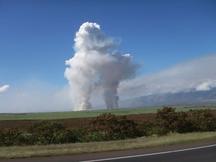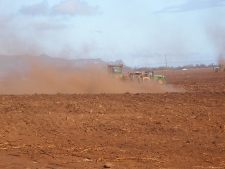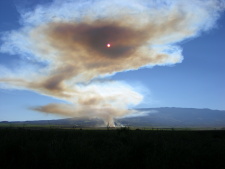Community discontent smolders over continued HC&S cane burning
by Rob Parsons
 Where there's smoke, there's poor air quality |
 |
 |
It happens with regularity: a smoked-out resident pens a letter to the local newspaper, chastising Hawaiian Commercial & Sugar (HC&S) for persisting with the archaic practice of burning sugar cane fields before harvesting. The writer cites air quality degradation and health risks, lack of regulatory oversight, messy black ash or “Hawaiian snow,” and calls for alternatives, such as growing food for local consumption.
Then
the fun begins. Inevitably, other letter-writers quickly come to the
defense of the plantation, with a nostalgic posture that often defies
reason. Sugar may not be perfect, they opine, but it provides jobs and
keeps Central Maui green. Make HC&S stop burning, the authors say,
and they’ll go under. Then the isthmus will revert to a dustbowl, or
worse yet, it will all become urbanized.
Finally, someone will
take the debate to the lowest common denominator: thinly veiled racism
or provincialism. “How dare you newcomers tell us how to live our
lives? If you didn’t like cane burning, why did you move here? And
maybe you should move back.”
Twelve years ago this month, in
1997, Kihei resident Susan Douglas wrote a letter to the editor
concerning cane burning, and left her voicemail number. Over 50 people
called wanting to do something about the situation, and the Maui Clean
Air Coalition (MCAC) was born. Meetings were held; more than 250 people
showed up at a public hearing in Kihei attended by a representative
from the Environmental Protection Agency’s Region 9 San Francisco
office.
The coalition engaged the plantation in
discussions about viable harvesting alternatives. At the same time,
they formed a legal committee to study the possibility of a class
action lawsuit.
The MCAC went so far as contacting Tilby,
a Canadian company with patented equipment for cane harvesting and
processing. Tilby proposed, at their own cost, building a separate
tower adjacent to the existing Puunene Mill with equipment to separate
sugar chaff from the cane stalk, and to manufacture ethanol and
fiberboard. They hoped the county would agree to run its fleet of
vehicles with the locally produced biofuel. But the proposal fizzled
and faded away, and in time, so did the momentum of the MCAC.
Fast
forward to three weeks ago, when an Upcountry resident created a
Facebook group called Maui Clean Air. The forum is “dedicated to
actively exploring, researching, educating, and empowering the Maui
community to clean up our air.” The site has swiftly grown to nearly
300 members and comments have been posted detailing communications with
state Department of Health and EPA representatives, as well as listing
research on pollutants found in cane burning residue.
And thus, a new round of letters has been launched on The Maui News opinion page. A Kula resident attributed asthma problems to Madame Pele
and worsening vog from Kilauea’s vents. A Wailuku resident stated that
sugar has kept the valley green and “prevented the dust storms that
would rage through it.”
There is no doubt that air quality
throughout the islands has suffered in recent years due to emissions
from the Big Island volcano. But shouldn’t that be all the more reason
to find alternatives to open field burning? Maui Electric Company
(MECO) power plants in Kahului and Maalaea were 6th and 9th,
respectively, on the state list for top producers of harmful emissions,
according to the EPA’s Toxic Release Inventory. (A cursory search did
not turn up where HC&S’s Puunene Mill landed on the emissions list
for 2008. The EPA tracks and regulates point source emissions, but not
those from open field burning. There is only one air quality monitoring
site on Maui, in Kihei, and data is averaged over a 24-hour period,
meaning extreme conditions from burning dissipate and don’t trigger air
quality violations.)
Kihei’s Dr. Lee Altenberg, a UH associate
professor and native plant enthusiast, refuted the Central Maui dust
bowl myth more than a decade ago. Responding to misinformation in The Maui News,
Altenberg wrote: “Harry Eagar’s usually informative column, Off
Deadline, was full of errors Dec. 31 [1997] when confronting the issue
of sugar growing in Maui’s central valley. He spreads the fallacy that
Maui’s central valley was “naturally” a wasteland before sugar
cultivation. The natural state of the valley was a thick dryland
forest. In this forest, giant flightless ducks, nene and other birds
roamed among trees that grew nowhere else in the world. Eagar compares
the valley to the Arizona desert. Find me one town in Arizona named for
flocks of geese that lived there, as Pu‘u Nene is named. The
Polynesians reduced this forest to a grassland by recurrent burning as
a means to cultivate grass for thatches. But it was cattle that turned
the valley into a dust bowl. Beginning in 1793, for a whole generation
cattle were let loose to run over Maui. Cattle, pigs, goats and deer
turned virtually all of Hawaii’s dryland forest areas into dust. A Natural History of the Hawaiian Islands, edited by E.A. Kay (available in area bookstores), gives abundant details.”
 |
 |
 |
The
perpetuation of the idea that only sugar can keep the central valley
green ignores the potential for myriad food or fuel crops that might
serve the same purpose, while using far less water than sugar cane. It
also overlooks the plantation’s practice of clearing hundreds of acres
at a time, leaving topsoil vulnerable to Maui’s strong trade winds and
producing regional dust storms.
In 1994, Pukalani resident
Herb Squires helped convene an effort to end cane burning, bringing
various stakeholders together for the Alternatives to the Burning of
Sugar Cane Committee. Meeting regularly over the better part of a year,
the ad hoc group included representatives from the County Council,
A&B, HC&S, ILWU, MECO and the Hawaii Sugar Planters Association
(back before plantation operations such as Pioneer Mill and Hamakua
Sugar went belly-up).
The committee’s final recommendation was
to acquire machinery to strip the leaves of harvested cane, at a
projected cost of $2 million dollars. HC&S went so far as to work
on blueprints, while Squires pursued grant funding to help defray the
cost. But ultimately, the idea went nowhere.
I met with
then-plantation manager Steve Holaday in early 2003, and he related
that equipment cost estimates for green-harvesting cane were $30
million. Two years later, we met again, this time with MCAC’s Douglas
and a Wailea resident who was concerned with the deleterious health
impacts on his family.
Holaday told us they had crunched
the numbers and believed the cost to retrofit their operation would be
a whopping $101 million. Whether those projected costs were realistic
or not, I understood that HC&S had no intentions of budging on the
issue anytime soon.
Late in 2005, the topic hit the headlines
again when the U.S. Department of Agriculture’s Air Quality Task Force
heard public testimony as part of an 11-hour meeting at the Renaissance
Wailea Beach Resort. The USDA task force was familiar with agricultural
burning in places like Idaho and Washington, done to discourage plant
disease and vermin, but those burns are generally conducted just once a
year—as opposed to HC&S, which burns Monday through Saturday,
February through December, weather permitting.
The Maui News reported comments I made to the panel, relaying dozens of concerns and
complaints registered with my office as Maui County Environmental
Coordinator and executive assistant to Mayor Alan Arakawa, and those of
other testifiers. Once again, the debate raged on the letters page,
with patience wearing thin for many.
Soon, like a school kid
summoned to the principal’s office for chewing gum in class, I was
asked to address the issue at the Maui County Farm Bureau’s monthly
meeting with the Mayor. I sat back and listened to the “concern” they
had that I had spoken out on the matter.
I responded by reading a Honolulu Advertiser commentary that advocated self-reliance in food and fuel. “There are
few places more vulnerable right now than Hawaii,” the article stated,
with billions of dollars leaving the state to import both commodities.
“Hawaii has the opportunity,” the piece continued, “to turn two of our
biggest challenges—fuel and food—into two of our biggest economic
successes.”
Mayor Arakawa, while not stating opposition to cane
burning, did come to my defense. “You have a situation with a conflict
between the environment and the economy,” he said. “This issue needs
work. If you don’t address it, it’s likely to get worse.”
Vilifying
HC&S for their reluctance to change is likely to strain the bonds
of already divided contingencies in our community. Instead, it may be
most productive to pursue viable economic and agricultural options—not
only to cane burning, but to the mono-cropping of some 35,000 acres,
which requires more and more pesticides, herbicides, fungicides and
chemical fertilizers.
Diversified, locally focused agriculture
would also provide many more jobs than sugar, which only employs about
one person per 45 acres. On top of that, A&B’s agricultural sector
lost nearly $13 million last year, so surely corporate executives must
see the handwriting on the wall.
 |
 |
 |
What if A&B provided
regional plots for community gardens, as Maui Land & Pineapple did
in 2006 with two acres adjacent to Haliimaile? Perhaps they could
engage the community in a planning charette for a new agricultural
future, similar to when they sought input on a proposed new community
in the Waiale Road area near Waikapu.
Long-term decisions for
Maui are often made in A&B’s corporate boardrooms in Honolulu, and
haven’t generally met with community approval. How refreshing it would
be to see them step into a new paradigm of community-based planning,
and to collaborate on strategies to mutually benefit Maui’s
agricultural viability and the local economy.
Hey A&B execs, are you on Facebook?